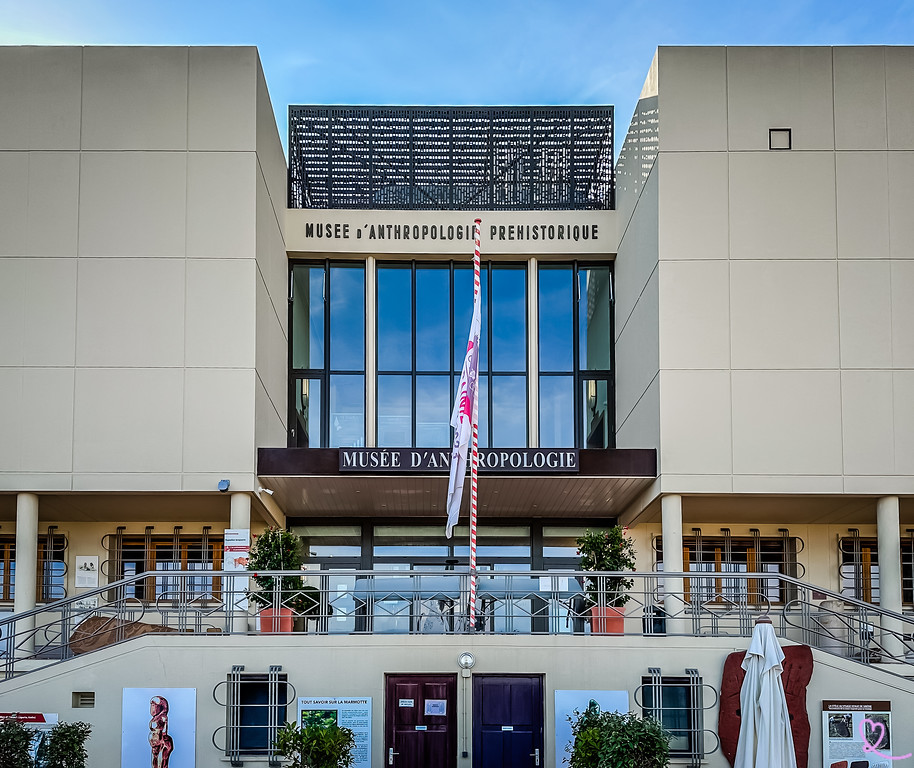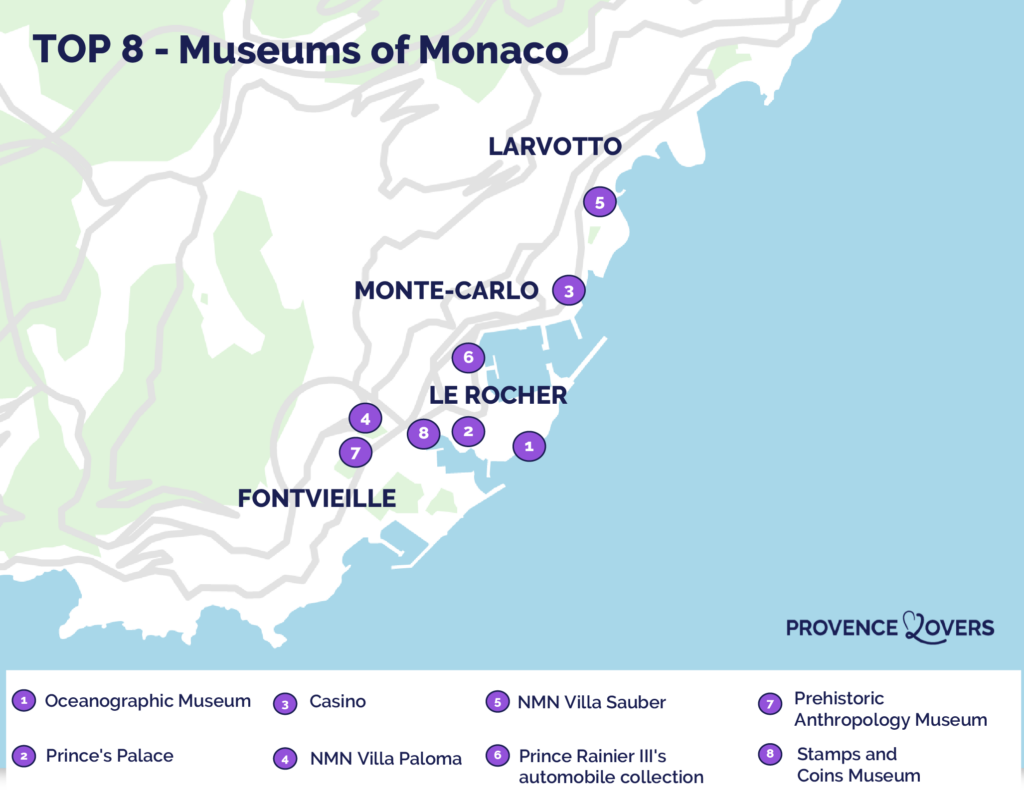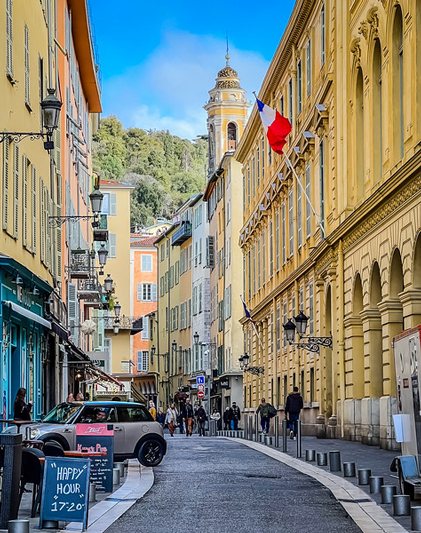Want to find out more about prehistoric remains on the Côte d’Azur and anthropology in general? We recommend a visit to Monaco’s Museum of Prehistoric Anthropology. You’ll learn a lot about the civilizations that came before us, through furniture, utensils, burials and bones.
Here are some useful tips for planning your visit to the Museum of Prehistoric Anthropology in the Principality of Monaco.

This guide is completely independent, based on our experiences. We visited the region anonymously, making our own choices and paying our bills in full.
Is a visit to the Museum of Prehistoric Anthropology worthwhile?
Yes, this museum, founded by Prince Albert I in 1902, is well worth a visit. In fact, we listed it in our article on the best museums in Monaco. Although the museum’s mix of old and new features may confuse some visitors, the two rooms that make up the museum offer a wealth of information. The first enables us to trace the major developments in the history of mankind. The second displays prehistoric remains found in the principality, notably in the nearby Jardin Exotique cave. We’ve learned that over a million years ago, the Côte d’Azur was already a favored habitat for our prehistoric ancestors. We were also able to discover a temporary exhibition.
In our opinion, this is one of the best things to do in Monaco, especially with the whole family!

What you can see
A Roman sarcophagus

As we began our visit, we took time to observe the objects installed outside. We saw many stelae, but it was this beautiful Roman sarcophagus that caught our eye. It’s very interesting because it dates from the first half of the 3rd century, a period of transition between pagan and Christian sarcophagi. The medallion in the center represents the deceased (a man of letters, judging by the scroll in his hand), while the masks ward off evil spells.
Burials

We then entered the Salle Albert I, dedicated to general prehistory. There we discovered an exhibition offering a journey through time, from Monaco to Chile. A large part was dedicated specifically to funeral rites. We’d also like to point out that a large number of bones and skeletons will be exhibited in this type of museum. If you are sensitive to this, we advise you to find out more beforehand. We saw a mummy, for example, as well as this female skeleton dating from the Palaeolithic period.
Steles

A little further on, we were impressed by this stele, which was highlighted by its central location in the room. Thanks to an explanatory panel, we were able to understand the significance of the motifs engraved on them, which represented the journey of the deceased to heaven. This stele was found in Mongolia, on the Tsatsyn Ereg site. By the time you get to the museum, it may no longer be on display, but you’ll no doubt be able to see others on the terrace.
Furniture and utensils

We were also able to observe numerous pieces of furniture and utensils. They are an invaluable source of information for anthropologists, as they tell them about the lifestyles of past civilizations. As part of the exhibition, ancient ceramics were on display, as well as this 11th-15th century Chilean grating tablet. Chileans used to put hallucinogenic substances in them, which they then breathed in through their noses.
Innovative devices

We were surprised by the scenography, which featured both old-fashioned devices (sheets rather than solid labels or panels, objects displayed in circular glass cabinets) and more innovative presentations. For example, we spotted this hologram, representing a bronze panther sculpture (1st-3rd AD), housed at the Musée d’Archéologie Nationale in Saint-Germain-en-Laye (35min from Paris).
An impressive mammoth skeleton

We then entered the Salle Rainier III, dedicated to regional prehistory. The tour was dedicated to the discoveries of Prince Albert I. We were able to understand the origins of the museum’s collection, and how it was created. We were particularly attracted by this impressive mammoth skeleton. Unearthed from the Arctic Circle in the 1990s, it measures 2.8m in height and its tusks reach almost 2.5m!
A piece of prehistoric beach

We were also impressed by this sedimentary limestone rock, made up of fossil shells. We’d never seen anything like it before! Discovered between the end of the 19th century and the beginning of the 20th century, it comes from a cave that no longer exists. It was located close to the sea, on the Italian side, right next to the beautiful French town of Menton.
A pleasant terrace overlooking the Rocher

Before leaving the museum, take time to enjoy its terrace. It is very pleasant and an integral part of the visit. Objects are displayed here as an extension of the exhibits. You’ll also see explanatory panels on Monaco’s major architectural achievements of different periods. We found them interesting. They acted as an orientation table. Thanks to this, we were able to enjoy the superb panorama of Port-Hercule and the Rocher with a more seasoned eye!
Monaco Museum of Prehistoric Anthropology: access
Where is the museum?
- The museum is located in the hills above Monaco, near the Jardin Exotique in the Condamine district.
- It’s a 20-25 minute walk from the station.

Access by car and parking
The nearest parking lot (5min walk) is the Jardin Exotique parking lot. It charges for parking of 1 hour or more, and is open 24 hours a day.
OUR TPS FOR RENTING YOUR CAR IN Provence
- Compare prices on our preferred platform: DiscoverCars – one of the best rated sites.
- Choose a car that is powerful enough (the roads are steep) but compact (some passages are narrow).
- Think of thecomplete insurance (some roads are tortuous and narrow).
- There is a lot of demand, book it early.

Public transport access
To get there by public transport, take bus lines 2 and 3 to the “Villa Paloma” stop. To plan your route, visit the official transport network websitehere.
Visiting difficulties
The museum is currently inaccessible to people with reduced mobility. The entrance is via staircases, as is access to the upstairs exhibition rooms. An accessibility project is under study.
Visiting the Museum of Prehistoric Anthropology: useful tips
Schedules and prices
The museum is open daily from 9am to 6pm. Admission costs €1 (free for children under 5 and residents of the Principality).
A combined ticket is also available for the nearby Jardin Exotique and the New National Museum of Monaco(Villa Sauber and Villa Paloma).
See the latest news on the official website here.
How long
Allow 20-45 minutes for your visit, as the museum is relatively small.
Best moment
The museum is rarely visited. However, we advise you to go there in the morning to make sure you’re not disturbed. The nearby Jardin Exotique attracts a huge number of visitors, especially during the school vacations.
Direction of visit
There’s no set direction for the tour. As for us, we began by visiting the Salle Albert Ier, then the Salle Rainier III, before enjoying the terrace and the exhibits.
Visiting with children
The museum is child-friendly, as evidenced by this coloring table in the exhibition areas. We’ve noticed a number of such devices, with explanatory commentaries aimed specifically at children. The museum is particularly committed to young visitors, with special guided tours, events, escape games…To find out more, please consult the program on the official website here.

Eating out
On-site vending machines sell drinks and sweets. For a real meal, we recommend heading for the Fontvieille district below. You’ll find some great addresses, which we’ve listed in our article on the best restaurants to eat in Monaco.
Hotels
There are no hotels in the museum district. We recommend the Colombus Hôtel in the Fontvieille district (25min walk). You can also go to Port-Hercule or even further afield to find the right establishment for you. Here are our recommendations:
WHERE TO STAY IN Monaco
Option 1: In Monte Carlo
Discover luxury palaces in Monaco’s most sought-after district:
- Hotel de Paris – see prices, pictures and availability
- Hermitage Hotel – see prices, photos and availability
- Hotel Métropole – see prices, photos and availability

Option 2: Larvotto
Close to Larvotto beach, you’ll find some splendid resort hotels.
We recommend..:
- Monte-Carlo Bay Hotel & Resort – view prices, pictures and availability
- Le Méridien Beach Plaza – view prices, pictures and availability

Option 3: At Port-Hercule
Boutique hotels, with superb views of the port and the Rock.
- Hotel Miramar – prices, pictures and availability
- Port Palace – see prices, photos and availability




